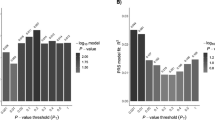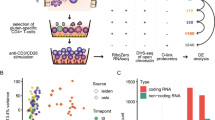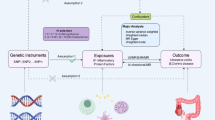Abstract
It is increasingly evident that different inflammatory disorders show some overlap in their pathological features, concurrence in families and individuals, and shared genetic factors. This might also be true for coeliac disease, a chronic inflammatory disorder of the gastrointestinal system, which shares two linkage regions with inflammatory bowel disease: on chromosome 5q31 (CELIAC2 and IBD5) and 19p13 (CELIAC4 and IBD6). We hypothesised that these regions contain genes that contribute to susceptibility to both disorders. The overlapping 5q31 region contains only five positional candidate genes, whereas the overlapping 19p13 region has 141 genes. As the common disease gene probably plays a role in inflammation, we selected five functional candidate genes from the 19p13 region. We studied these 10 positional and functional candidate genes in our Dutch coeliac disease cohort using 44 haplotype tagging single-nucleotide polymorphisms. Two genes from 19p13 showed a small effect on familial clustering: the cytochrome P450 F3 gene CYP4F3 (Pnominal 0.0375, odds ratio (OR) 1.77) and CYP4F2 (Pnominal 0.013, OR 1.33). CYP4F3 and CYP4F2 catalyse the inactivation of leukotriene B4 (LTB4), a potent mediator of inflammation responsible for recruitment and activation of neutrophils. The genetic association of LTB4-regulating gene variants connects the innate immune response of neutrophil mobilisation with that of the established Th1 adaptive immunity present in coeliac disease patients. The findings in coeliac disease need to be replicated. Expanding genetic association studies of these cytochrome genes to other inflammatory conditions should reveal whether their causative influence extends beyond coeliac disease.
Similar content being viewed by others
Log in or create a free account to read this content
Gain free access to this article, as well as selected content from this journal and more on nature.com
or
References
Macdonald TT, Monteleone G : Immunity, inflammation, and allergy in the gut. Science 2005; 307: 1920–1925.
Babron MC, Nilsson S, Adamovic S et al: Meta and pooled analysis of European coeliac disease data. Eur J Hum Genet 2003; 11: 828–834.
Van Belzen MJ, Meijer JW, Sandkuijl LA et al: A major non-HLA locus in celiac disease maps to chromosome 19. Gastroenterology 2003; 125: 1032–1041.
Rioux JD, Silverberg MS, Daly MJ et al: Genomewide search in Canadian families with inflammatory bowel disease reveals two novel susceptibility loci. Am J Hum Genet 2000; 66: 1863–1870.
van Heel DA, Satsangi J, Carey AH, Jewell DP : Inflammatory bowel disease: progress toward a gene. Can J Gastroenterol 2000; 14: 207–218.
Schreiber S, Rosenstiel P, Albrecht M, Hampe J, Krawczak M : Genetics of Crohn disease, an archetypal inflammatory barrier disease. Nat Rev Genet 2005; 6: 376–388.
Van Heel DA, Fisher SA, Kirby A, Daly MJ, Rioux JD, Lewis CM : Inflammatory bowel disease susceptibility loci defined by genome scan meta-analysis of 1952 affected relative pairs. Hum Mol Genet 2004; 13: 763–770.
Ueda H, Howson JM, Esposito L et al: Association of the T-cell regulatory gene CTLA4 with susceptibility to autoimmune disease. Nature 2003; 423: 506–511.
Begovich AB, Carlton VE, Honigberg LA et al: A missense single-nucleotide polymorphism in a gene encoding a protein tyrosine phosphatase (PTPN22) is associated with rheumatoid arthritis. Am J Hum Genet 2004; 75: 330–337.
Bottini N, Musumeci L, Alonso A et al: A functional variant of lymphoid tyrosine phosphatase is associated with type I diabetes. Nat Genet 2004; 36: 337–338.
Zhernakova A, Eerligh P, Wijmenga C, Barrera P, Roep BO, Koeleman BP : Differential association of the PTPN22 coding variant with autoimmune diseases in a Dutch population. Genes Immun 2005; 6: 459–461.
Cottone M, Marrone C, Casa A et al: Familial occurrence of inflammatory bowel disease in celiac disease. Inflamm Bowel Dis 2003; 9: 321–323.
Schedel J, Rockmann F, Bongartz T, Woenckhaus M, Scholmerich J, Kullmann F : Association of Crohn's disease and latent celiac disease: a case report and review of the literature. Int J Colorectal Dis 2005; 20: 376–380.
Tursi A, Giorgetti GM, Brandimarte G, Elisei W : High prevalence of celiac disease among patients affected by Crohn's disease. Inflamm Bowel Dis 2005; 11: 662–666.
Yang A, Chen Y, Scherl E, Neugut AI, Bhagat G, Green PH : Inflammatory bowel disease in patients with celiac disease. Inflamm Bowel Dis 2005; 11: 528–532.
Rioux JD, Daly MJ, Silverberg MS et al: Genetic variation in the 5q31 cytokine gene cluster confers susceptibility to Crohn disease. Nat Genet 2001; 29: 223–228.
Monsuur AJ, Bakker PI, Alizadeh BZ et al: Myosin IXB variant increases the risk of celiac disease and points toward a primary intestinal barrier defect. Nat Genet 2005; 37: 1341–1344.
Gabriel SB, Schaffner SF, Nguyen H et al: The structure of haplotype blocks in the human genome. Science 2002; 296: 2225–2229.
Barrett JC, Fry B, Maller J, Daly MJ : Haploview: analysis and visualization of LD and haplotype maps. Bioinformatics 2005; 21: 263–265.
Peltekova VD, Wintle RF, Rubin LA et al: Functional variants of OCTN cation transporter genes are associated with Crohn disease. Nat Genet 2004; 36: 471–475.
Tello-Ruiz MK, Curley C, DelMonte T et al: Haplotype-based association analysis of 56 functional candidate genes in the IBD6 locus on chromosome 19. Eur J Hum Genet 2006; 14: 780–790.
Matter K, Balda MS : Signalling to and from tight junctions. Nat Rev Mol Cell Biol 2003; 4: 225–236.
Mankertz J, Tavalali S, Schmitz H et al: Expression from the human occludin promoter is affected by tumor necrosis factor alpha and interferon gamma. J Cell Sci 2000; 113 (Part 11): 2085–2090.
Diosdado B, van Bakel H, Strengman E et al: A genomics view on celiac disease points to enhanced neutrophil recruitment and barrier impairment, 2005, (submitted).
Helaakoski T, Annunen P, Vuori K, MacNeil IA, Pihlajaniemi T, Kivirikko KI : Cloning, baculovirus expression, and characterization of a second mouse prolyl 4-hydroxylase alpha-subunit isoform: formation of an alpha 2 beta 2 tetramer with the protein disulfide-isomerase/beta subunit. Proc Natl Acad Sci USA 1995; 92: 4427–4431.
Christmas P, Jones JP, Patten CJ et al: Alternative splicing determines the function of CYP4F3 by switching substrate specificity. J Biol Chem 2001; 276: 38166–38172.
Christmas P, Ursino SR, Fox JW, Soberman RJ : Expression of the CYP4F3 gene. Tissue-specific splicing and alternative promoters generate high and low K(m) forms of leukotriene B(4) omega-hydroxylase. J Biol Chem 1999; 274: 21191–21199.
Kikuta Y, Kusunose E, Endo K et al: A novel form of cytochrome P-450 family 4 in human polymorphonuclear leukocytes. cDNA cloning and expression of leukotriene B4 omega-hydroxylase. J Biol Chem 1993; 268: 9376–9380.
Kikuta Y, Miyauchi Y, Kusunose E, Kusunose M : Expression and molecular cloning of human liver leukotriene B4 omega-hydroxylase (CYP4F2) gene. DNA Cell Biol 1999; 18: 723–730.
Greene TA, Powell P, Nzerem C, Shapiro MJ, Shapiro VS : Cloning and characterization of ALX, an adaptor downstream of CD28. J Biol Chem 2003; 278: 45128–45134.
Oda T, Muramatsu MA, Isogai T, Masuho Y, Asano S, Yamashita T : HSH2: a novel SH2 domain-containing adapter protein involved in tyrosine kinase signaling in hematopoietic cells. Biochem Biophys Res Commun 2001; 288: 1078–1086.
Altare F, Durandy A, Lammas D et al: Impairment of mycobacterial immunity in human interleukin-12 receptor deficiency. Science 1998; 280: 1432–1435.
Chua AO, Chizzonite R, Desai BB et al: Expression cloning of a human IL-12 receptor component. A new member of the cytokine receptor superfamily with strong homology to gp130. J Immunol 1994; 153: 128–136.
Watanabe T, Kitani A, Murray PJ, Strober W : NOD2 is a negative regulator of Toll-like receptor 2-mediated T helper type 1 responses. Nat Immunol 2004; 5: 800–808.
Arunachalam B, Phan UT, Geuze HJ, Cresswell P : Enzymatic reduction of disulfide bonds in lysosomes: characterization of a gamma-interferon-inducible lysosomal thiol reductase (GILT). Proc Natl Acad Sci USA 2000; 97: 745–750.
Acknowledgements
We thank all the patients, their physicians, pathologists and the Dutch Coeliac Disease Foundation for participating in this study. We thank Jackie Senior for critically reading the manuscript. This study was supported by grants from the Netherlands Organisation for Scientific Research (Grant 912-02-028), the Dutch Digestive Diseases Foundation (Grants 97-44 and 03-06) and the Coeliac Disease Consortium, an Innovative Cluster approved by the Netherlands Genomics Initiative and partially funded by the Dutch Government (Grant BSIK03009). JDR was supported by grants from the American National Institute of Diabetes and Digestive and Kidney Diseases and the Crohn's and Colitis Foundation of America.
Author information
Authors and Affiliations
Corresponding author
Additional information
Supplementary Information accompanies the paper on European Journal of Human Genetics website (http://www.nature.com/ejhg)
Supplementary information
Rights and permissions
About this article
Cite this article
Curley, C., Monsuur, A., Wapenaar, M. et al. A functional candidate screen for coeliac disease genes. Eur J Hum Genet 14, 1215–1222 (2006). https://doi.org/10.1038/sj.ejhg.5201687
Received:
Revised:
Accepted:
Published:
Issue date:
DOI: https://doi.org/10.1038/sj.ejhg.5201687
Keywords
This article is cited by
-
Proteomic Analyses Lead to a Better Understanding of Celiac Disease: Focus on Epitope Recognition and Autoantibodies
Digestive Diseases and Sciences (2010)
-
Searching for genes influencing a complex disease: the case of coeliac disease
European Journal of Human Genetics (2008)



